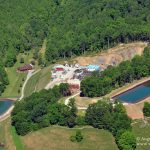- West Virginia Record article on decision compliments WVSORO
Amicus Brief in SUpreme Court - Gas drilling lawsuit sent back to lower court by W.Va. Supreme Court (News article)
- Coal companies and others file new appeal in lower court
- WVSORO also files new appeal in lower court in different county
- WVSORO allowed to interevene in coal company appeal; WVSORO appeal moved to same county.
- Coal Association and other petitioners, and WVSORO the intervener-petitioner file their initial briefs
- Chesapeake, WVSORO and others file answering briefs
- Reply briefs filed by Coal Association and others and by WVSORO.
- Oral Arguments in Marcellus Well Spacing Case
Here is a Pennsylvania web site with a video that illlustrates how close together Marcellus Shale wells might be
Additional Information and Background
The latest “play” in the oil and gas industry is to the Marcellus formation. Over two thousand gas wells are planned over most of the “gas patch” in West Virginia.
We are getting many questions because landmen are blanketing West Virginia and approaching surface owners who are lucky enough to still own their minerals and not have leased them yet. Most of this increased activity is about leasing and drilling to the Marcellus formation. These landmen are trying to get surface owners to sign their “standard” lease that gives little surface use protections, gives less than $20 an acre up front money, and has clauses allowing things that are very bad for surface owners including storage, injection and secondary recovery. The bad clauses can be negotiated out of the lease, surface owner protections can be negotiated in. Before the leasing boom started, the standard delay rental or bonus was $5 an acre, and it was a big deal if you got $25. By August of 2008, prices had jump to sometimes $2500 an acre! Then the recession hit and prices vary a lot but are as low as $75 an acre to $500 or $1000 depending more now on what formation the driller is looking for and whether the land is in a hot spot or not. We have therefore started a whole new page on leasing for for surface owners who are being approached by landmen.
Well spacing is good for surface owners because only the number of wells necessary to produce the gas will be drilled. Without well spacing, the “rule of capture” applies and the driller with the right to drill on every mineral tract included in a pool of gas, no matter how small, can drill his own well and legally steal the gas from his neighboring mineral owners. The result is extra, unnecessary wells racing to get the gas out first from the same pool. In fact, the extra unnecessary wells will result in less total gas getting produced out of the pool, leaving some of the resource in place, than if the smaller right number of wells were used.
Well spacing is good for consumers because drilling fewer wells to get out more gas means less cost to get out the gas. It is good for everyone else in the process because it saves money and produces more gas than using the extra wells that get drilled with the “rule of capture” applies. (‘Royalty sharing” goes hand in hand with well spacing. It allows the sharing of royalties among all the mineral owners that each well drains. In the statutes this process is called “pooling and unitization”)
Drillers can only be forced to do well spacing if the well is a statutory “deep well” (and those are unusual), or if it is a shallow well above a coal seam and the coal seam owner wants it, or if it is a coal bed methane well.
Also, if the well is a “statutory “deep well’” the driller MAY have to get new consent form the surface owner to drill on the surface owner’s land! Unfortunately the State is interpreting that provision in a very narrow way.
There is currently a dispute whether wells into the Marcellus formation are statutory “deep wells” requiring well spacing and royalty sharing, or whether they are statutory “shallow wells” allowing the rule of capture.
WV SORO likes have the Marcellus formation wells being statutory “deep wells”. The wells will be spaced properly so there are fewer wells. In addition, more surface owners will get to consent to the well location.
The State Oil and Gas Conservation Commission has ruled that Marcellus wells are statutory deep wells. Here is the text and map of the legal advertisement for the Oil and Gas Conservation Commission’s proceeding ruling on thousands of acres in Kanawha, Clay, Roane and Braxton Counties. Here is the Commission’s order in the proceeding for Boone, Lincoln and Logan Counties. There were other proceedings and other orders for other areas. Here is a map of the areas that are the subject of these proceedings.
WV SORO is pleased that the Oil and Gas Conservation Commission also ruled that the Marcellus wells are deep wells, but does not like its ruling that the wells could be spaced within on 1000 feet of each other, instead of 3000 or at least 1500 feet of each other.
At a special session of the Legislature in 2007 and then at the 2008 regular session the bad guys tried to get the Legislature to pass a statute overruling the Commission. WV SORO and others were able to kill it.
As that failed, the West Virginia Coal Association and some oil and gas drillers filed a Petition for a “Writ of Prohibition” in the West Virginia Supreme Court of Appeals to prevent the Oil and Gas Conservation Commission from declaring Marcellus wells to be “statutory” “deep wells”. Here is a copy of the Petition and here are the exhibits that were attached to the Petition. Here is a copy of the Brief of the State agency defending its position that the Marcellus wells are deep wells. Here are briefs of Chesapeake Appalachia and of Eastern American Energy Corporation also defending the agency decision.
WV SORO filed a “friend of the court brief” in the Supreme Court case. Attached is our Motion for leave to file the brief together with the Amicus Brief itself. The Supreme Court issued an order granting our motion to consider the amicus brief.”
The petitioners then filed a Reply Brief, to which WV SORO filed a second amicus response.
Oral argument was March 12, 2008. WV SORO’s amicus brief was referred to.
On May 27, 2008, the West Virginia Supreme Court issued an order denying the petition to declare that Marcellus wells to be shallow wells. So for now Marcellus wells are still statutory “deep” wells as ruled by the Oil and Gas Conservation Commission. However, the Supreme Court granted 30 days to file an appeal in Circuit Court.
The Coal industry and others have now filed a petition in the Circuit Court of McDowell County again saying that the Marcellus Shale wells are not statutory deep wells. However, WVSORO has also filed its own petition challenging a part of the rulings of the Oil and Gas Conservation Commission. Ours is filed in Kanawha County Circuit Court. (The two appeals will probably end up being consolidated in one county or the other.) Our appeal agrees with the Oil and Gas Conservation Commission that the Marcellus Shale wells are statutory deep wells, but disagrees that spacing should only be 1000 feet between Marcellus Shale wells. We say it should be 3000 feet or at least 1500 feet. Here is a copy of WVSORO’s petition with Exhibit #3 and the clerk’s date stamp in color.
The Coal Association and others then filed a motion to consolidate the cases by moving the Kanawha County case that WVSORO filed with the McDowell County case that they filed. WVSORO responded by filing a pleading objecting to that motion and making a motion to move the McDowell County case to Kanawha County and consolidate them there instead. Court rules provide that the decision of where to consolidate the cases is made by judge in the county where the first appeal was filed. In this case this is is Judge Murensky in McDowell County. He heard oral argument on that motion on November 10, 2008, and said he would send out a written decision soon.
Meanwhile, the Coal Association and others filed a motion to dismiss the WVSORO appeal in Kanawha County stating that WVSORO does not have “standing”. WVSORO filed a Response to that motion. It will not be ruled upon until Judge Murensky decides whether the cases should be consolidated into McDowell County or Kanawha County.
On January 14, 2009, Judge Murensky issued an order ruling that the Kanawha County case should be transferred to McDowell County where both cases will now be heard.
Because the opposition has moved to dismiss WVSORO’s appeal, WVSORO has decided to ask the judge to “intervene” in the appeal originally filed in McDowell County by the coal companies and others. WVSORO filed a motion to intervene, and a proposed answer to their petition for appeal with a proposed WVSORO cross-petition for appeal.
Judge Murensky set oral argument on the motion to dismiss the WVSORO suit and on WVSORO’s motion to intervene in the suit filed by the coal companies and others on May 15, 2009, at 1:15 p.m. in the McDowell County Courthouse.
Judge Murensky has issued an order allowing WVSORO to intervene in the petition for appeal filed by the Coal Association and the Pocahontas Land Company and others. WVSORO has issued a press release with more details.
Coal Association and other petitioners, and WVSORO the intervener-petitioner file their initial briefs
Blue Eagle, the Coal Association, Pocahontas Land and other petitioners filed an initial brief that these are statutory “shallow wells” and spacing should be controlled by the Shallow Gas Well Review Board. WVSORO filed an initial brief as an intervening petitioner taking the position that these Marcellus Shale wells drilled more than 20 feet into the underlying Onondaga are statutory “deep wells”, but that the Commission’s 1000 foot spacing order was too narrow.
Chesapeake, WVSORO and others file answering briefs
Chesapeake, Eastern American, and Quest (successor to Petroedge) all filed answering briefs taking the position that these are deep wells, but that the 1000 foot spacing was proper. The West Virginia Oil and Gas Conservation Commission answering brief took the same position. WVSORO also filed an answering brief agreeing that these are deep wells, but referring to its initial brief for the position that 1000 foot spacing was too close together.
Reply briefs filed by Coal Association and others and by WVSORO.
The briefing schedule is concluded with a reply brief filed by WVSORO, and a reply brief filed by the Coal Association and others.
Oral Arguments in Marcellus Well Spacing Case
On a beautiful autumn day, October 19, 2009, deep in the coal country town of Welch, McDowell County, oral arguments in the well spacing case took place before Circuit Judge Rudolph J. Murensky, II.
There were lawyers representing the various parties with interests in coal, land, and oil and gas, and the West Virginia Oil and Gas Conservation Commission. David McMahon, co-founder of WVSORO, and a public interest lawyer, presented oral arguments representing the interests of surface owners. See this newsletter article for more



